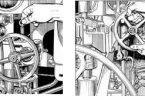How did the need of AIS arise? / Why do we need AIS ?
- OOW has to continuously watch out against the danger of collision.
- The OOW continuously monitors movements of ships around to avoid close quarter situation.
- He uses visual, aural or electronic means to carry out this monitoring.
- Such monitoring becomes inadequate if movement and intention of another vessel are unclear.
- It then becomes very critical to communicate with such a ship.
- With number of ships in the vicinity, confusion about a ships identity can be dangerous.
- The need to positively identify a ship has became more urgent because of presence of faster and larger ships, increasing traffic density and zero tolerance for pollution which invariably occurs after a collision.
- AIS provided the solution for easy identification.
How does AIS work? / What is principle of operation of AIS?
AIS consists of 1xVHF transmitter, 2xVHF TDMA receivers, 1xVHF (DSC) receiver, and internal links to ships Gyrocompass, GPS & ship’s log.
AIS transmitter automatically broadcasts information about ships position, COG, SOG and CPA/TCPA at regular intervals on two VHF Maritime Frequencies of 161.975 Mhz & 162.025 Mhz.
AIS gleans this data from ship’s GPS and Gyrocompass.
The AIS transmitter also transmits static information like ships identity, IMO Number, her cargo, her destination etc which is manually inputted during installation and at the beginning of the voyage.
Ships in the vicinity with AIS transmit their own information during their own time slots, which are so allotted that there is never any interference between two transmission.
This is achieved by using a patented STDMA technology which does continuous synchronization of all AIS stations in the area.


